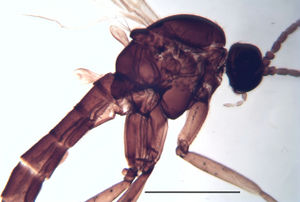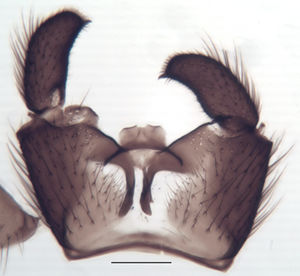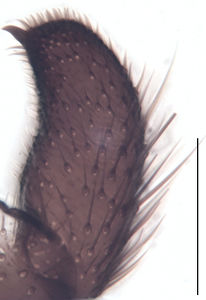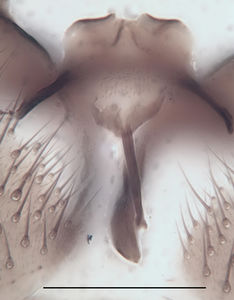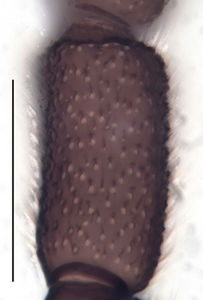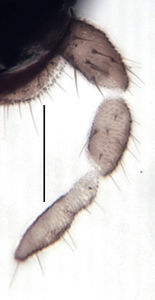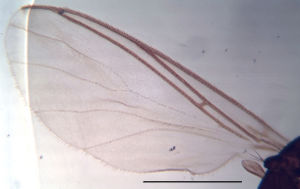Trichosiopsis sveae
Ordo: Diptera
Familia: Sciaridae
Genus: Trichosiopsis
Name
Trichosiopsis sveae unpublished
Type material
Holotype: ♂, 13.3.–20.3.2014, Malaise trap, leg. Kassebeer, ZFMK-TIS-2583561 in ZFMK
Type locality
Germany, Schleswig-Holstein, Oldenburg, Putlos
Barcoded material
| Stadium | Country | Province | Locality | Habitat | Method | Date | Collector | Collection Number | Collection | Latitude | Longitude | Elevation (m) |
|---|---|---|---|---|---|---|---|---|---|---|---|---|
| 1 ♂ (holotype) | Germany | Schleswig-Holstein | Oldenburg, Putlos | Truppenübungsplatz | Malaise trap | 13.3.–20.3.2014 | Christian Kassebeer | ZFMK-TIS-2583561 | ZFMK | 54.3166 | 10.8022 | 20 |
| 1 ♀ | Germany | Schleswig-Holstein | Oldenburg, Putlos | Truppenübungsplatz | Malaise trap | 13.3.–20.3.2014 | Christian Kassebeer | ZFMK-TIS-2583564 | ZFMK | 54.3166 | 10.8022 | 20 |
| 1 ♀ | Germany | Schleswig-Holstein | Oldenburg, Putlos | Truppenübungsplatz | Malaise trap | 13.3.–20.3.2014 | Christian Kassebeer | ZFMK-TIS-2583562 | ZFMK | 54.3166 | 10.8022 | 20 |
| 1 ♀ | Germany | Schleswig-Holstein | Oldenburg, Putlos | Truppenübungsplatz | Malaise trap | 31.8.–7.9.2014 | Christian Kassebeer | ZFMK-TIS-2583537 | ZFMK | 54.3166 | 10.8022 | 20 |
| 1 ♀ | Germany | Schleswig-Holstein | Oldenburg, Putlos | Truppenübungsplatz | Malaise trap | 31.8.–7.9.2014 | Christian Kassebeer | ZFMK-TIS-2583536 | ZFMK | 54.3166 | 10.8022 | 20 |
| 1 ♀ | Germany | Schleswig-Holstein | Oldenburg, Putlos | Truppenübungsplatz | Malaise trap | 31.8.–7.9.2014 | Christian Kassebeer | ZFMK-TIS-2583532 | ZFMK | 54.3166 | 10.8022 | 20 |
| 1 ♂ | Germany | Schleswig-Holstein | Oldenburg, Putlos | Truppenübungsplatz | Malaise trap | 31.8.–7.9.2014 | Christian Kassebeer | ZFMK-TIS-2583531 | ZFMK | 54.3166 | 10.8022 | 20 |
| 1 ♀ | Germany | Schleswig-Holstein | Oldenburg, Putlos | Truppenübungsplatz | Malaise trap | 20.4.–27.4.2014 | Christian Kassebeer | ZFMK-TIS-2583528 | ZFMK | 54.3166 | 10.8022 | 20 |
| 1 ♀ | Germany | Schleswig-Holstein | Oldenburg, Putlos | Truppenübungsplatz | Malaise trap | 20.4.–27.4.2014 | Christian Kassebeer | ZFMK-TIS-2583527 | ZFMK | 54.3166 | 10.8022 | 20 |
| 1 ♂ | Germany | Schleswig-Holstein | Oldenburg, Putlos | Truppenübungsplatz | Malaise trap | 27.4.–4.5.2014 | Christian Kassebeer | ZFMK-TIS-2583504 | ZFMK | 54.3166 | 10.8022 | 20 |
| 1 ♂ | Germany | Schleswig-Holstein | Oldenburg, Putlos | Truppenübungsplatz | Malaise trap | 27.4.–4.5.2014 | Christian Kassebeer | ZFMK-TIS-2583503 | ZFMK | 54.3166 | 10.8022 | 20 |
| 1 ♀ | Germany | Schleswig-Holstein | Oldenburg, Putlos | Truppenübungsplatz | Malaise trap | 6.10.–13.10.2014 | Christian Kassebeer | ZFMK-TIS-2583487 | ZFMK | 54.3166 | 10.8022 | 20 |
| 1 ♂ | Germany | Schleswig-Holstein | Oldenburg, Putlos | Truppenübungsplatz | Malaise trap | 30.3.–6.4.2014 | Christian Kassebeer | ZFMK-TIS-2583476 | ZFMK | 54.3166 | 10.8022 | 20 |
Other material studied
Germany: 1 ♂, Schleswig-Holstein, Putlos, Truppenübungsplatz, Malaise trap, Kassebeer, 14.-21.09.2014, PKHH 8817; The Netherlands: 3 ♂, Terschelling, Primärdünensukzession "groenplak", photoeclector, Vogels, 3.-17.04.2002, PKHH 4087/4088; 3 ♀, PKHH 4089; 1 ♂, 17.4.-06.05.2002, PKHH 4094.
Description (male)
Head. Eye bridge 4–5 rows of facets. Antenna unicolour. LW-index of 4th flagellomere 1.61–1.9; neck 0.2–0.28 × segment width; transition of basal part to neck pronounced. Colour of neck unicolour. Antennal setae shorter than segment width; fine; dense; adjacent. Palpus darkened; of normal length; palpomeres 3. First palpomere of normal shape; with 6–9 setae; with only sparse sensilla. Second palpomere short and oval. Third palpomere as long as first. Thorax. Colour brown. Notum unicolour. Thoracic setae normal; brown, or white, or of different colours. Posterior pronotum setose. Postpronotal setae 3–4; fine. Mesothoracic sclerites bare. Legs. Colour yellow-brown, or brown. Hind coxa of same colour as femora. Setae on front coxa pale. Front tibial organ as patch of setae; pale; front tibial organ not bordered. Tibial setae on hind legs normal, shorter than tibial width. Tibial spurs of equal length. Claws untoothed. Wing. Wing hyaline; with conspicuous anal lobe, or of normal shape. Wing membrane without macrotrichia. Wing venation weak, with faint stM. M-fork of normal shape. R1 ending at or slightly before base of m-fork; posterior veins with macrotrichia; stM mostly with macrotrichia; CuA1 and CuA2 mostly with macrotrichia; bM setose; r-m mostly setose; bM:r-M 0.96–1.16; st-Cu:bM 0.27–0.37; R1:R 1.4–1.7; c:w 0.55–0.65. Halter darkened; of normal length. Abdomen. Abdominal setae on tergites black; sternites white. Hypopygium concolour with abdomen; LW-index 0.57–0.67. Base of gonocoxites with weak setae; gonocoxites broadly separated; inner margin of gonocoxites typically U-shaped; inner membrane of hypopygium scarcely setose; ventral margin of gonocoxite with short setae. Gonostylus elongate; LW-index 2.3–2.45; Inner margin concave; apex equally rounded. Apical tooth present; without internal structure; of medium strength; LW-Index 1.5–2.4. Awl-like setae normal; present beneath apical tooth. Megasetae absent. Whiplash-hair absent. Tegmen rectangular with rounded edges; without special features; central process absent. Length of ejaculatory apodeme/hypopygium 19–27 %; base of ejaculatory apodeme present. Field with aedeagal teeth clearly visible. Measurements. Body size 3.5–4.5 mm. Hind tibia 1.55–1.75 mm. Wing length 2.8–3.6 mm.
Diagnosis
This is another typical species of the Trichosiopsis trochanterata complex, characterized by an elongate, tapered gonostylus and partly bright body hairs. It is similar to Trichosiopsis saltuum by the hyaline wings and the darkened legs. However, the characteristic shape and colouration of the tegmen allow an easy recognition.
DNA Barcoding
The COI sequence is assigned to BIN BOLD:ADG3080 (average distance 0.27%, max. 0.86%, n=13, K2P: 10.88%).
Etymology
The species is named after Svea, the daughter of the dipterist Christian Kassebeer, who collected the specimens.
Discussion
The finding of Trichosiopsis sveae demonstrates, that there are still a lot more species to be expected in what was formerly considered Tr. trochanterata. It proved to be very common at the type locality and may be typical for sandy dune habitats, because on the island Terschelling, Netherlands it was collected in the same kind of habitat.
The species has a very distinct DNA barcode and is not very close to the other members of the species complex.
Distribution
Germany, Netherlands.
Images
|
